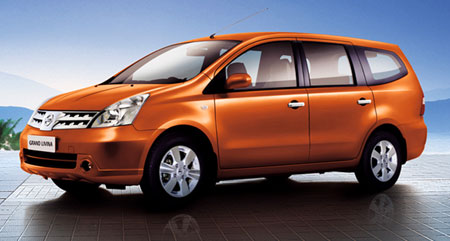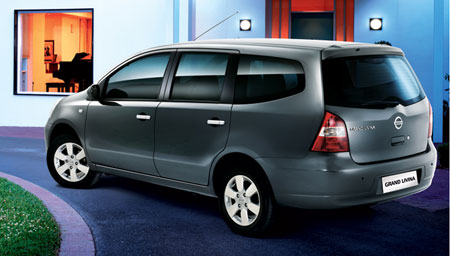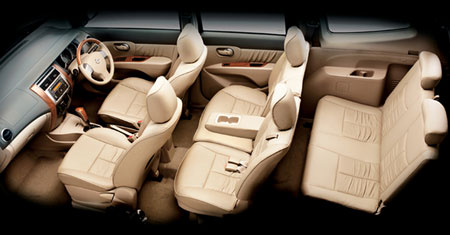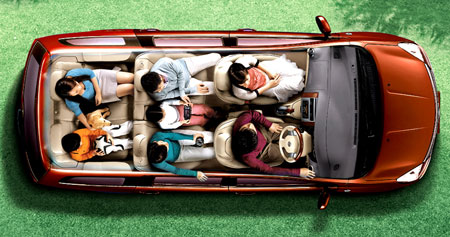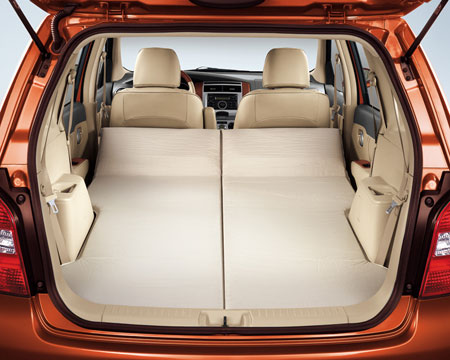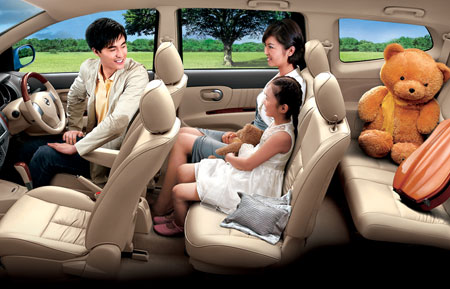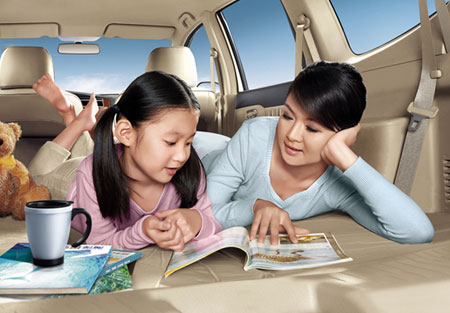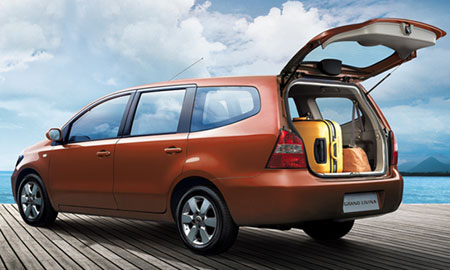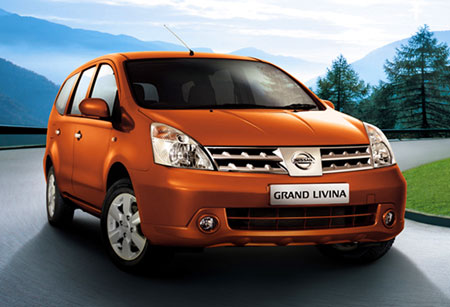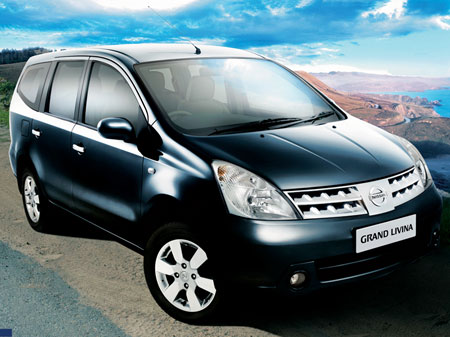| Tengku Azizan is perhaps the longest-serving employee in Proton, having been with it since even before the company’s first car rolled out. Over the years, he has been involved in testing prototypes in Malaysia and overseas and today heads the team that does homologation and testing of products. For many years now, I’ve told him that I would love to do a story on his career because it must be an exciting and very interesting job testing prototypes of models which won’t be in showrooms until some years later. But being the good corporate man, he’s always suggested that I 'talk to the PR department first and get their approval’ before he could agree to an interview. I’ve tried on and off but never really gotten down to that interview yet. So it was a surprise to get a message from him inviting me to a 'TT’ (teh tarik session) - and also mention of driving 'the MPV’ to Temerloh the next day. The invitation really was a surprise, not that he had seemingly agreed to chat with me but that he was telling me that the MPV – which was obviously the Exora – was to be present. I was so puzzled that I even SMS back whether I would get to sit with him in the MPV because it was hard to believe I could be allowed to do so! We’ve always talked about his prototype testing and how his team has to sneak out late at night to avoid being caught by spy photographers and though I have tested prototypes of other companies in Malaysia and other countries, I never asked him to allow me because I believed he would not be able to agree due to strict company policy. In fact, he told me they really work hard not to be spotted when they are on the road and if pictures start to appear, then there will be 'problems with the bosses’. The invitation was the day before, as I said, and I had another appointment but I felt this was such a rare opportunity that I postponed it. Actually, I did not realize that the session was specially organized for me as I had assumed it was one of their many test runs, now safe to be conducted in broad daylight since the launch was only a month away, and I was just being offered a chance to tag along. When I told Tengku Azizan that I actually had an appointment, he kindly offered me another chance 'next week’ but I felt that the offer was so good that I would be silly to postpone it because the following week, things may be different.  | So I turned up at the Proton carpark early in the morning very excited about the drive and Tengku Azizan told me there would be two Exoras available, a manual and an automatic. Because I had to be back in town by 2 pm, we would not go as far as Temerloh and I could decide where I wanted to go. He also had a number of his team members come along because he knew that one of the things which would need to be assessed was the performance of the MPV with a full load of seven on board. It was very thoughtful of him and knowing that his guys are very busy, I have also to thank them for coming along for the ride. I didn’t expect to be allowed to take pictures and didn’t try and in any case, the Proton people requested that I use only those pictures which have already appeared in the Exora ads and none at all from the drive session if I needed to illustrate my report. They trusted me enough not to make me sign a million ringgit indemnity form if I didn’t follow their request and I see no reason why I should make them feel their trust was unjustified.  |
I had a go in the manual first and when I settled into the driver’s seat, the first thing I checked out was the driving position. In the Waja and models on the same platform, the driving position never seemed right – somehow the relationship between the steering wheel, its angle and the seat were awkward and it seemed like the people who chose such a relationship were thinking of a sporty driving position. That’s fine if you are doing a Lotus but not if you are doing a sedan for everyday commuting and certainly not for a MPV. In the Exora, which has a brand new platform, the constraint of that driving position is not there and they have had a chance to get it right and this time, they have. It’s a very comfortable position and being a MPV, the seating height is higher which gives a commanding view forward. Women drivers especially will appreciate this as it promotes confidence. Having had experience with the Campro CPS already, I expected the same character but discovered that the one in the Exora had a different feel. It felt stronger at the low end with more linear power delivery than what I remembered. I was told that they had done some tuning to match the engine to the increased weight (a figure of 1,400 kgs was mentioned) and driving style expected. More significantly, the gear ratio has been changed which does help in the take-off. However, I noticed that the engine speed at 100 km/h was 2900 rpm which is somewhat high by today’s standards (the Toyota Vios 1.5-litre engine spins at 2600 rpm at the same speed) and can have implications on fuel economy (more on this later). There’s not much to assess a manual transmission really and the only thing I found was that the shifting was a bit notchy. This could have been an adjustment issue since the unit was a prototype and production versions may not have the same notchiness. Steering feel was very good, precise and correctly weighted. On the smooth Karak highway, I didn’t notice it but over rough surfaces and ripples, I felt that the feedback was on the high side. This could be a consequence of making the steering feel precise and most people will probably be okay with it. However, in places like East Malaysia and rural areas where roads are rough, the vibrations coming through the steering wheel during long periods of driving could contribute to fatigue, not to mention being irritating. At the BHP station along the Karak highway, I switched to the automatic since there was not much else to discover about the manual. Tengku Azizan said that the automatic would probably sell in larger numbers so I thought I should give it more attention. Like the manual, the engine in the automatic also felt more lively, more eager at the low end. What I liked though was the gated shifter. For those who are not familiar, a gated shifter (you can see it in the picture) has a shift lever slot that is not straight. Mercedes-Benz was the first to introduce this concept in the 1970s and the various positions have more defined 'slots’ to allow more positive selection. It is not like the tiptronic transmission which is an automatic transmission with manual shift (sequential) capability but it is just an automatic transmission with a specially-shaped slot and you can select lower gears manually. Personally, I like a gated shifter more than a tiptronic because the feel is more like that of a manual transmission whereas a tiptronic transmission in manual mode only executes shifts with a very short movement up or down (or left or right). Paddle shifts on the steering wheel are, of course, a different matter.  |
The shifts in the automatic were pretty smooth though not seamless and in some conditions, kickdown was a bit too abrupt. But what was important was that there was no 'hunting’ of gears, suggesting that the Transmission Control Unit (TCU) has been well programmed and properly matched to the engine characteristics. In some other cars I’ve driven with poor matching, the transmission would keep trying to find the right gear and downshift even on a slight incline. That’s very annoying and I am pleased to say that the Exora has none of that behaviour. Also very surprising to me was the smoothness of the engine at cruising speeds. Above 110 km/h, the Campro CPS engine ran so smoothly and quietly and it was not entirely due to sound insulation. Now comes the part where I answer one of the Big Questions about the Exora’s performance: can it go up the Genting road? Well, I didn’t use the road to Genting Highlands because it’s usually crowded and I prefer the Bukit Tinggi road. I’m more familiar with that road so if there was any comparison to be made, that would have been a better road for me and I used it for the Exora. The question about whether the Exora or any car can go up a hilly road is, to me, unnecessary. Any car and lorry can go up a hill and what people really want to know is how fast it can go and that depends on expectations. A familyman who cares about safety for himself and his family isn’t going to expect to drive to the top of Bukit Tinggi like that guy in InitialD, right? He will want to be able to drive at a decent speed without the engine having to roar at 6000 rpm, both of which the Exora – with 7 guys aboard – can easily do. The Campro CPS engine in the Exora has adequate power and torque to meet such a requirement satisfactorily and I believe that 90% of people would have no complaints. The other 10% who may feel it is 'under-powered’ would be those who expect performance levels like a Waja or Persona and they are probably not the target buyers for a MPV anyway. I won’t talk about the fuel consumption since the driving I did was rather fast and hard, not how a real owner would be driving. As I said, the high rpm at cruising speeds does suggest that consumption might be affected but until I actually do a run using our own route and procedure, I can’t say for sure and it would not be fair to make a judgement at this time. Another thing which I noticed driving around was that in many MPVs, there were usually a number of children which means that the load is not as great as 7 adults. And the occasions when there are likely to be 7 adults would probably be in town when office colleagues go for lunch in one vehicle. In such a situation, it’s unlikely that there will be any issues about performance. That’s one major question answered so I’ll move on to ride and handling. This area gets top marks and I was really impressed. Of course, Protons since the Satria GTI have had above-average handling thanks to Lotus technology and experience. It’s the one area no one has ever criticized and with the MPV, it is clear that the engineers have done wonders with their skills. I would rate it as the best in its class – not the best among all MPVs in the world – and the closest rival in this department would be the Naza Citra II Rondo which has a rather European feel about it. When I mentioned this comparison to Tengku Azizan, he found it interesting and suspected that the Kia people (the Rondo is adapted from a Kia Carens) may have had Lotus Engineering do some chassis tuning work too! Getting the Exora to handle so impressively might have meant sacrificing ride comfort, something which could not be allowed in a family-type vehicle. Surprisingly, the ride comfort was also very good. Not soft like a French MPV but firm like a European one. Even on broken roads and bumps, the Exora maintained it poise and body roll was negligible. Most MPVs in this class tend to roll a bit when you push them hard through corners but the Exora cornered like a car! No kidding! I would also add that the brakes worked very well and the feel was excellent. This is not what I would say of other Proton models and certainly not for the Satria Neo CPS which I drove recently and was surprised that the brakes were spongy. But with the Exora, I felt confident even braking hard late in corners to see how much the nose dipped (very little).  | Strength of body structure of the Exora has been given a lot of attention, especially at the front. Its rigidity also makes the ride and handling very impressive | |
I would have suggested to Proton an advertising tagline like 'a 2-seater with space for 7’ but Honda already describes their Stream like that! And talking of the Stream, I would say that the Honda MPV along with the Mazda5 and Toyota Wish should not be considered rivals to the Exora. They are a notch higher and I doubt very much if someone who has eyes on any of them would consider the Exora. The more obvious rivals would be the Nissan Grand Livina, Toyota Avanza and Naza Citra, all of which are selling very well but will definitely lose sales to the Exora when it becomes available. What about the Toyota Innova? Some people considering an Innova might look at the Exora but the Toyota has a larger engine (and a higher price as well).
Noise, vibration and harshness (NVH) were commendably low even though the unit was not a mass production one. In the rear seat, road noise could be heard but this is not unexpected because of the open space at the back. What was telling about the sound insulation was during the storm that we had to drive through. With low-priced models, roof insulation is often kept to a minimum for cost reasons but I don’t think this is the case with the Exora because there was no intrusive sound from the roof even with raindrops hammering down on it. Now that we’ve moved inside, let’s talk about the packaging and accommodation. The cabin width felt generous and the large size of the front seat would also suggest this. I sat in the middle row briefly and didn’t take too much note but Paul Tan (who had his session a week after me) commented that the middle row gets much more legroom than it needs to have. As for the third row, I made sure I checked it out and sat there all the way from the Genting tunnel to Shah Alam. The space was fine for me and about the same as what is in a Grand Livina (and I also sat in its third row for a very long period during a test-drive in Bali). From the first sighting of the bodyshell during the Proton Technology Week a while back, I wondered about the third side window. It seemed like a rather small opening and I felt that it could mean the people in the third row would have something like a small window like on an aircraft, which is not particularly pleasant. However, when I sat inside and looked out, the amount of glass area is actually quite large and kids will have a nice view of the world passing by. Comfort-wise, the seats are well structured but I felt that the cushion thickness might be on the thin side. I’m not sure if this is because the interior designers wanted to get as much headroom as possible but if it is thin, then fatigue could set in on long distances. This only applies to the second and third rows as the front two seats are fine.  |
As the pictures show, the second and third row can fold down completely flat which is very good. However, the folding operation for the second seat didn’t seem so good though owners may eventually get used to it. It is not a straightforward operation and salesmen had better practice doing it so they do not struggle in front of potential customers! Incidentally, the head restraints are low-profile types which do not have to be removed when the seats are flat. Looking around the cabin, I was impressed by the innovative thinking the interior designers had and I suspect a large portion of the R&D budget went to creating an interior that is among the best in this class of MPVs. At a workshop with Proton’s interior designers a couple of years ago, I had emphasized this as being very important because it is something that is related to perceived quality. Earlier models didn’t have the right textures and panels appeared cheap and plasticky. Some of the trim in the Exora was untextured because it was a prototype but I feel sure that the texture will be the right type in the production units because the latest Waja CPS is very well done. Maybe the interior designers did feel I had a point and have worked hard at it.  | One teh tarik hook is under the front head restraint and the other is on the dashboard | |
The Proton designers know that the one thing I have always asked about is a little thing called a teh tarik hook. I am sure you know what it is and many vehicles have it as standard. It’s a simple feature but very useful because our culture is such that we do have a lot of plastic bags of teh tarik,nasi lemak and so on. In the past, people would hang these on the door handles; okay but not the best way. So, to me, it has been odd that Proton being a Malaysian product did not have such a feature from the start and yet it is standard in a Kia, Honda, Toyota and other foreign makes (even the Land Rover Discovery!). I was told that this feature was a 'must-have’ for the Exora because they did not want me bringing it up again! Actually, even though the Proton people associate me with the teh tarik hook, I must explain that it was really the late Dato’ Gurcharan Singh, the first GM of EON, who brought it up. During the media launch of the Saga 1.5I in 1987 or 1988, he complained that there was no 'char kuey teow’ hook for him to hang the packet of noodles and he felt that was something a Malaysian Car should have as standard. The cupholders and bottle holders get high marks. You may think that these are all the same but a good cupholder is deep so that the cup does not topple over when you corner. The ones in the Exora (there are ten) are very well designed, perhaps the best I have seen. Those right at the back, along the sides below the third windows, have a slot for magazines or comics, something which is also thoughtful.  | Stowage pockets for seatbelt buckles are a plus point | |
Other nice things are the neat storage of the seatbelts on the second and third rows (not all manufacturers think of this) and this will also make sure that there are no customers asking why the seatbelts are missing. In quite a number of cases I have heard, customers are puzzled to find their rear seatbelts missing. Actually the seatbelts are underneath and during installation of the seat, the people are too lazy to pull them up and just leave them on the floor and drop the seat on top. The most expensive version will have a DVD player mounted on the ceiling somewhere above the gap between the front seats. It’s a standalone unit rather than integrated with the audio head unit. I think it also takes SD card media. As for the dashboard, the design is clean and contemporary. There are some carryover parts from other models but it did surprise me to see quite a lot of new parts which means a higher initial cost of production. Perhaps this also suggests that there are new suppliers and Proton has finally been able to get rid of those that caused its reputation to go downhill by supplying parts with sub-standard quality.  | You should be able to answer calls using the integrated Bluetooth connection by pressing a button on the steering wheel | |
The instrument panel has a nice presentation and the only thing I would have an issue with is reflections at the top (inside the shroud) because the surface is too shiny and smooth. Tengku Azizan said that it was not the final trim and the 'ghosting’ I noticed would not be present in the production model. The Honda-like steering wheel has a nice feel and has some buttons for operating the radio and handsfree connection via Bluetooth. The Bluetooth facility is welcome and will help in motoring safety. The only thing about these Bluetooth facilities in cars is that the standards keep evolving and some manufacturers like to be right up to date. This can mean that some older handphones have problems connecting because their Bluetooth version is older. I mentioned this to Tengku Azizan and he said that they would try to test as many different phones as possible and see if any had problems and then get the supplier to make the necessary adjustments. One thing which you won’t see even in the showroom vehicles but which is also innovative is a Body Control Module. This is something which can control multiple functions in a vehicle and some of the features which I was told about were things like activation of the hazard warning lights during emergency braking and disabling of the central locking system (in unlocked position) if a child operated it more than 30 times in 30 seconds. With a Proton, there is always the final question – what about build quality? I can’t answer that since the units I drove were prototypes and I accept that they had parts which would not be in the production models. But I feel sure the quality will be high going by what we’ve seen of the New Saga. It would be a real shame if all the fantastic efforts of the engineers and interior designers in developing one of the best MPVs in its class had poor quality. So that’s about as much as I can tell you about the experience of driving the first truly Malaysian MPV. If you think that my positive views are enough and you do not need further convincing and you want to be among the first to own an Exora, then go and book one now (you only need RM1,000 to do so). And if you can't decide on the colour choices, the two new ones - Pyrite Brown and Gaia Blue – look very suitable for the Exora. | 





 Crowds looking at the new Exora at a Proton Edar branch.
Crowds looking at the new Exora at a Proton Edar branch.










